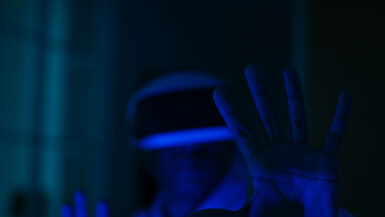In today’s fast-paced, technology-driven world, it’s becoming increasingly important to understand the impact of blue light exposure on our well-being, particularly during pregnancy. Expectant mothers face unique challenges in balancing the demands of daily life and maintaining healthy sleep patterns. This article delves into the complex relationship between blue light exposure, sleep quality, and productivity, specifically during pregnancy. We will explore the science behind blue light’s impact on our circadian rhythm, discuss the potential consequences of disrupted sleep on both maternal and fetal health, and provide practical tips for effectively managing blue light exposure to ensure restorative sleep and optimal productivity during this critical time.
Digital Devices and their Role in Pregnancy Sleep Patterns
As our dependence on digital devices continues to grow, expectant mothers need to be aware of the potential impact these devices can have on their sleep patterns during pregnancy. The widespread use of smartphones, tablets, and laptops exposes us to an increasing amount of blue light, which has been shown to disrupt our natural sleep-wake cycles. In this section, we will explore the role of digital devices in pregnancy sleep patterns, discuss the potential risks associated with excessive blue light exposure, and provide practical strategies for managing screen time during pregnancy.
The Science Behind Blue Light and Circadian Rhythms
Blue light is a high-energy visible (HEV) light with a wavelength of 400-500 nanometers, emitted by digital devices such as smartphones, tablets, and laptops. This type of light has been found to suppress melatonin production, a hormone that plays a crucial role in regulating sleep-wake cycles. As a result, excessive blue light exposure during the evening can delay sleep onset, disrupt circadian rhythms, and reduce sleep quality. This is especially concerning during pregnancy, as quality sleep is essential for both maternal and fetal health. For more information on the relationship between blue light and sleep, you can read our article, Blue Light and Sleep: What Parents Need to Know.
Consequences of Poor Sleep on Maternal and Fetal Health
Poor sleep during pregnancy can have significant consequences for both the mother and developing fetus. For expectant mothers, inadequate sleep can lead to increased stress, reduced immune function, and a higher risk of developing pregnancy-related complications such as gestational diabetes and preeclampsia. Moreover, disrupted sleep can also impact fetal development, as research has suggested connections between maternal sleep quality and fetal growth, development, and overall health.
Practical Strategies for Managing Screen Time During Pregnancy
To minimize the impact of blue light exposure on sleep patterns during pregnancy, expectant mothers should consider implementing the following strategies to manage screen time effectively:
1. Establish a digital curfew: Set a specific time in the evening to stop using digital devices, ideally at least one hour before bedtime.
2. Use blue light filters: Many devices have built-in settings that reduce blue light emissions during evening hours, or you can download third-party apps that perform the same function.
3. Optimize bedtime environment: Create a sleep-friendly bedroom by minimizing exposure to artificial light, maintaining a comfortable temperature, and incorporating relaxation techniques such as meditation or gentle stretching.
4. Prioritize daytime exposure to natural light: Spend time outdoors during daylight hours to help regulate your circadian rhythm and improve sleep quality.
By understanding the potential impact of digital devices on sleep patterns during pregnancy, expectant mothers can make informed choices about screen time and prioritize healthy habits that contribute to a restorative sleep and optimal productivity.
Tips for Reducing Blue Light Exposure for Better Sleep
As expectant mothers navigate the challenges of balancing blue light exposure and sleep during pregnancy, it’s essential to implement strategies that minimize the impact of blue light on sleep quality. In this section, we will provide practical tips to help pregnant women reduce blue light exposure, thus ensuring better sleep and overall well-being. We will also explore how blue light affects sleep in different populations, such as the military, to further our understanding of this critical issue.
Embrace Blue Light Blocking Technologies
Many devices now offer built-in blue light filters or “night mode” settings that reduce blue light emissions during evening hours. Alternatively, you can download third-party apps that perform the same function. Additionally, consider investing in blue light blocking glasses, which can filter out harmful blue light wavelengths without affecting color perception.
Reevaluate Your Evening Routine
To minimize exposure to blue light before bedtime, establish a digital curfew and stop using digital devices at least one hour before sleep. Replace screen time with relaxing activities that promote sleep, such as reading a physical book, practicing gentle stretching, or engaging in mindfulness exercises.
Optimize Your Sleep Environment
Creating a sleep-friendly bedroom can help counteract the effects of blue light exposure. Consider installing blackout curtains to block artificial light from entering the room, and use low-wattage, warm-colored light bulbs to minimize blue light emissions from lamps. Additionally, maintaining a comfortable temperature and incorporating soothing sounds, such as white noise, can further promote a restful night’s sleep.
Learn from Diverse Populations: Blue Light and the Military
To gain a broader understanding of the connection between blue light and sleep, it’s helpful to examine its impact on various populations. For example, The Connection Between Blue Light and Sleep in the Military highlights the unique challenges faced by military personnel who often endure long hours of screen time and irregular sleep schedules. Insights from these populations can help expectant mothers better understand the importance of managing blue light exposure for optimal sleep.
Reducing blue light exposure during pregnancy is crucial for both maternal and fetal health. By embracing blue light blocking technologies, reevaluating evening routines, optimizing sleep environments, and learning from diverse populations, expectant mothers can effectively balance blue light exposure and sleep to ensure a healthy, productive pregnancy.
Effects of Blue Light on Sleep Quality during Pregnancy
Understanding the impact of blue light exposure on sleep quality during pregnancy is essential for expectant mothers seeking to maintain a healthy balance between their digital lives and sleep. In this subsection, we will delve into the specific effects of blue light on sleep quality during pregnancy, and explore the potential consequences for both maternal and fetal well-being. Furthermore, we will highlight the importance of adopting strategies to minimize blue light exposure for a more restful and rejuvenating sleep experience.
Disruption of the Circadian Rhythm and Melatonin Production
Exposure to blue light, particularly in the evening, can interfere with the body’s natural circadian rhythm – the internal clock that regulates sleep-wake cycles. Blue light suppresses melatonin production, a hormone that plays a crucial role in inducing sleep. Consequently, excessive blue light exposure during pregnancy can delay sleep onset, disrupt sleep patterns, and reduce overall sleep quality, potentially affecting both mother and baby’s health.
Increased Risk of Insomnia and Sleep Disorders
The impact of blue light on sleep quality can also manifest as an increased risk of insomnia or other sleep disorders during pregnancy. Insomnia, characterized by difficulty falling or staying asleep, can exacerbate the already challenging sleep issues that many expectant mothers face. Sleep disorders not only impair the quality of rest but can also contribute to mood disturbances, reduced immune function, and an overall decline in well-being.
Implications for Maternal Health and Fetal Development
Poor sleep quality during pregnancy, exacerbated by blue light exposure, can have significant implications for both maternal health and fetal development. For expectant mothers, inadequate sleep can lead to increased stress levels, a higher risk of gestational diabetes and preeclampsia, and compromised immune function. Furthermore, research has suggested connections between maternal sleep quality and fetal growth, development, and overall health, underlining the importance of addressing blue light exposure as a contributing factor to sleep disturbances.
Adopting Strategies for Improved Sleep Quality
Given the detrimental effects of blue light on sleep quality during pregnancy, it is vital for expectant mothers to adopt strategies to minimize exposure and promote healthy sleep habits. These strategies may include establishing a digital curfew, utilizing blue light filters or blocking glasses, and optimizing the sleep environment for relaxation and restfulness. By recognizing and addressing the impact of blue light on sleep, pregnant women can work towards achieving a more balanced and healthy lifestyle for themselves and their babies.
Understanding Blue Light Exposure in Pregnant Women
As we continue to explore the impact of blue light on sleep and productivity during pregnancy, it is crucial to delve into the unique aspects of blue light exposure specifically in expectant mothers. This subsection aims to provide a comprehensive understanding of the sources and potential consequences of blue light exposure in pregnant women, as well as the factors that may exacerbate its effects on sleep. We will also discuss the importance of raising awareness and providing support to pregnant women in managing blue light exposure for better sleep and overall well-being.
Sources of Blue Light Exposure for Pregnant Women
While the primary source of blue light exposure for pregnant women is digital devices such as smartphones, tablets, and laptops, it is important to recognize that blue light is also present in other sources. These may include televisions, LED and fluorescent lights, and even natural sunlight. Being aware of all potential sources of blue light exposure can help expectant mothers make informed decisions in managing their exposure and mitigating its impact on sleep.
Factors Exacerbating the Effects of Blue Light on Sleep
Several factors can exacerbate the effects of blue light exposure on sleep quality in pregnant women. These may include hormonal changes, increased stress levels, and physical discomfort associated with pregnancy. Additionally, lifestyle factors such as irregular sleep schedules, consumption of stimulants like caffeine, and lack of exposure to natural sunlight during the day can further intensify the impact of blue light on sleep. Addressing these factors is essential in mitigating the consequences of blue light exposure and promoting healthier sleep patterns during pregnancy.
Raising Awareness and Providing Support
Given the potential consequences of blue light exposure on sleep and productivity during pregnancy, it is important to raise awareness of this issue among expectant mothers, their families, and healthcare providers. Providing comprehensive resources and support can empower pregnant women to make informed decisions about their blue light exposure, ultimately contributing to better sleep and overall well-being. This support may include guidance on managing screen time, adopting blue light blocking technologies, and implementing healthy sleep habits to counteract the effects of blue light exposure.
The Importance of a Holistic Approach
Addressing the complex relationship between blue light exposure and sleep during pregnancy requires a holistic approach, taking into account not only the effects of blue light itself but also the various factors that can exacerbate its impact. By considering the interplay of hormonal changes, lifestyle factors, and individual circumstances, expectant mothers can develop tailored strategies for managing blue light exposure and achieving a healthier balance between their digital lives and sleep. This holistic approach can contribute to improved sleep quality, enhanced productivity, and overall well-being during this critical period.
Understanding blue light exposure in pregnant women is a vital aspect of promoting healthy sleep and productivity during pregnancy. By recognizing the sources, consequences, and exacerbating factors of blue light exposure, and providing awareness and support, expectant mothers can adopt a holistic approach to manage their exposure and achieve a healthier balance in their lives. This understanding can ultimately contribute to better sleep, enhanced productivity, and improved overall well-being for both mother and baby.
How Blue Light Impacts Pregnancy Hormones and Mood
During pregnancy, a delicate balance of hormones is essential for both the health of the expectant mother and the developing fetus. The impact of blue light on sleep during pregnancy may also extend to hormonal changes and mood regulation, as disrupted sleep can interfere with these processes. In this subsection, we will explore the connection between blue light exposure, pregnancy hormones, and mood, and discuss the potential consequences of this relationship for expectant mothers and their babies.
The Interplay of Melatonin, Cortisol, and Serotonin
As discussed earlier, blue light exposure can suppress melatonin production, a hormone that plays a critical role in regulating sleep-wake cycles. In addition to its effects on sleep, melatonin also influences the balance of other hormones, including cortisol and serotonin. Cortisol, known as the “stress hormone,” has a natural rhythm that typically peaks in the morning and gradually declines throughout the day. However, disrupted sleep due to blue light exposure can lead to elevated cortisol levels, which may contribute to increased stress and anxiety during pregnancy.
Serotonin, often referred to as the “feel-good hormone,” is essential for mood regulation and has a complex relationship with melatonin. Imbalances in serotonin levels, which can be influenced by disrupted sleep, may increase the risk of mood disturbances such as depression and anxiety in expectant mothers.
Implications for Maternal Mental Health
The impact of blue light exposure on pregnancy hormones and mood can have significant consequences for maternal mental health. Prolonged exposure to blue light and the resulting disruptions in sleep and hormonal balance may contribute to mood disorders such as antenatal depression and anxiety. These conditions not only affect the well-being of the expectant mother but can also have lasting implications for the developing fetus and the mother-infant bond.
Potential Effects on Fetal Development and Birth Outcomes
Research has suggested that maternal mood disturbances, which may be exacerbated by blue light exposure and disrupted sleep, can impact fetal development and birth outcomes. Elevated stress hormones such as cortisol can cross the placental barrier, potentially affecting fetal growth, neurological development, and long-term behavioral outcomes. Moreover, maternal mood disorders have been linked to an increased risk of preterm birth and low birth weight, highlighting the importance of addressing blue light exposure and its potential impact on pregnancy hormones and mood.
Strategies for Minimizing Blue Light Exposure and Supporting Hormonal Balance
In light of the potential consequences of blue light exposure on pregnancy hormones and mood, it is essential for expectant mothers to adopt strategies that minimize exposure and support hormonal balance. These strategies may include establishing a digital curfew, using blue light filters, and creating a sleep-friendly environment. Additionally, incorporating stress-reduction techniques such as mindfulness practices, gentle exercise, and social support can help counteract the potential impact of blue light exposure on hormonal balance and mood regulation.
Understanding the intricate relationship between blue light exposure, pregnancy hormones, and mood is crucial for maintaining the health and well-being of both expectant mothers and their babies. By implementing strategies to minimize blue light exposure and support hormonal balance, pregnant women can promote healthier sleep patterns and more stable mood regulation during this critical period in their lives. This understanding can contribute to a more positive pregnancy experience and foster a strong foundation for maternal and infant health.





Leave a reply